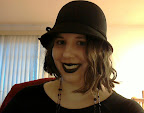
Go see The Artist.
No, really.
If you give a care about old movies, and if you are reading this blog in any capacity, I hope you do, this is a film you need to see.
Let me break this down: this is a silent, black and white film about the film industry around 1929, specifically the moment when films switched from silent to talkies. It tells the story of George Valentin, a popular silent film actor whose life is destroyed by the change, and Peppy Miller, an up-and-coming actress who starts her career as an extra during the silent era only to be promoted to leading lady when sound is introduced. Their stories are connected, as Peppy's first step into the film industry is brought about by an encounter with George, and it is crazy to see how their roles reverse.
To avoid spoilers (and also because I need to keep this blog relevant to its topic) I have to point out the way the silent style was used in this film. For one thing, this movie did NOT in any way shy away from silent era conventions. It wasn't just a movie made in 2011 that happened to be silent; it was a silent film. The background music is used almost as a tool to facilitate telling the audience how they should be feeling, combined with the somewhat exaggerated (by today's standards) methods of expressing and emoting. Things that might be deemed as being too "cheesy" by today's screenwriters make their way into the film with ease, such as a scene where George's dog saves his life.
However, the movie is constantly aware of its silence and what this means to the characters of the film. One scene in particular that startled me was when George's wife approaches him one day with the dialogue card of, "Why can't we talk?" Not only is she speaking for all the fired silent film actors who weren't given their chance to speak, she is finally emphasizing the fact that throughout most of the film, George and his wife never talk. Initially I read this as a means to show how their relationship is weak because there are no dialogue cards but it runs deeper than that. No dialogue cards, no flapping lips, and even no expressions showing how they feel towards each other. They aren't talking in every way.
In another scene, one of only two with sound, George puts something down on his vanity and it actually makes a noise. There is no music playing so it is clear to the audience that this strange thing has just occurred and George acts similarly shocked by hearing the sound, preceding then to move around the other objects on the table to hear that they make noise as well. George is living in a silent world even though talkies now exist and he doesn't know how to handle being able to hear things in the same way the audience doesn't know what to make of this sudden shift from silence.
On a final note about the plot (no spoilers), I absolutely love the way the relationship between George and Peppy is portrayed. Although they have romantic chemistry, the film never tries to push towards romance, instead happy to relish in Peppy's sense of devotion to her idol and mentor and their mutual respect for each other. It's a refreshingly realistic element in a film full of seemingly "unrealistic" 20s/30s film conventions.
This movie really could and should have only been made 80 years after the silent film has fallen out of fashion. Aside from the obvious fact that the switch from silent film to talkies really did bring about hardships like the ones endured by George Valentin in this film that would have been rough on such actors too soon after their careers have fallen apart, the film proves to modern audiences that this "archaic" art form is still powerful and can still be employed to great effect. We now live in a world where films are hastily converted into 3D as a marketing ploy, where a "Transformers" movie can be the highest grossing movie of the year with its abysmal acting, sloppy script, and gimmicky special effects up the wazoo, but guess what? Movie magic can still be made without any of those ploys.
Seriously, why are you still reading?
Go see it.


